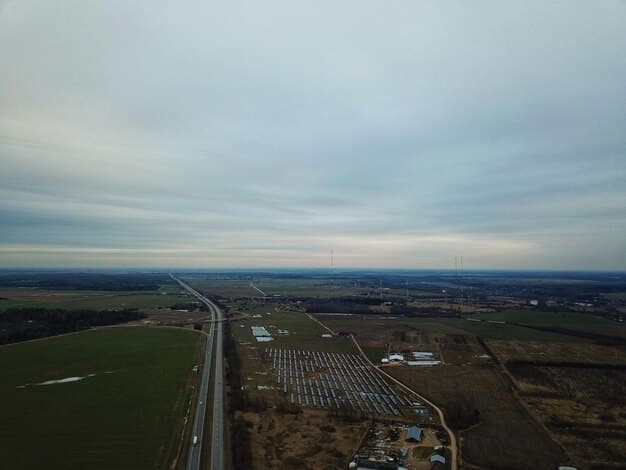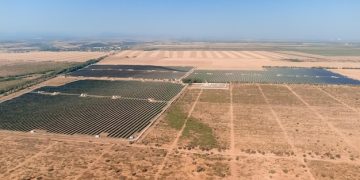White House Unveils New Climate Change Initiatives

The White House has recently revealed a series of comprehensive new initiatives aimed at accelerating the nation’s transition to a clean energy economy, bolstering climate resilience, and addressing environmental justice, marking a significant step in the ongoing fight against global warming and its pervasive impacts across the United States and globally.
In a pivotal moment for environmental policy, the White House Unveils New Initiatives to Combat Climate Change: What You Need to Know offers a comprehensive look into the Biden administration’s amplified strategy to tackle the escalating climate crisis. This commitment signifies a multifaceted approach, aiming to weave climate action into the fabric of economic growth and social equity.
Understanding the New Climate Framework
The new climate framework unveiled by the White House represents a significant escalation of efforts to combat global warming, moving beyond previous commitments to set ambitious new targets and introduce a range of policy tools designed to achieve them. This comprehensive strategy is built on several pillars, including decarbonizing the economy, investing in renewable energy infrastructure, and enhancing climate resilience across vulnerable communities. The administration emphasizes that these initiatives are not just about environmental protection but also about fostering economic growth, creating new jobs, and ensuring a just transition for all Americans. This integrated approach aims to leverage federal resources, streamline regulatory processes, and incentivize private sector investment to accelerate the shift away from fossil fuels. It recognizes that climate change is a cross-cutting issue requiring coordinated action across all sectors of society.
Key Policy Directives
The framework outlines several key policy directives that will guide federal agencies and programs. These directives span various sectors, from energy production and transportation to agriculture and urban development.
- Emissions Reduction Targets: The administration has committed to halving U.S. greenhouse gas emissions from 2005 levels by 2030, a target that aligns with global efforts to limit warming to 1.5 degrees Celsius.
- Clean Energy Transition: A major focus is on accelerating the deployment of renewable energy technologies, including solar, wind, and geothermal, and investing in next-generation energy storage solutions to ensure grid stability and reliability.
- Climate Resilience and Adaptation: Initiatives are designed to protect communities from the increasing impacts of extreme weather events, sea-level rise, and other climate-related hazards, through infrastructure upgrades and ecosystem restoration.
- Environmental Justice: A core component involves directing at least 40% of the benefits from federal investments in clean energy and climate solutions to disadvantaged communities that have historically borne the brunt of pollution.
The strategic implementation of these policies will involve interagency collaboration, engaging state and local governments, and fostering partnerships with businesses and civil society organizations. The White House recognizes that the scale of the climate challenge demands a whole-of-government approach, complemented by robust public engagement and international cooperation. This holistic view aims to ensure that climate action delivers tangible benefits for all Americans, improving public health, enhancing national security, and bolstering economic competitiveness in the global green economy. The administration is also keen on addressing the social and economic implications of the transition, ensuring that workers and communities dependent on fossil fuel industries are supported through retraining programs and economic diversification efforts.
The administration’s approach also includes a strong emphasis on leveraging scientific research and technological innovation to develop new solutions and improve existing ones. This involves significant investments in research and development, fostering public-private partnerships, and promoting the adoption of cutting-edge technologies. For instance, funding is being directed towards advanced battery storage, carbon capture technologies, and sustainable agricultural practices. Furthermore, the framework integrates climate considerations into foreign policy, aiming to re-establish U.S. leadership on the global stage and encourage other nations to deepen their climate commitments. This involves rejoining international agreements, participating in global climate forums, and providing financial and technical assistance to developing countries for their climate action initiatives. The goal is to build a global coalition committed to addressing climate change collectively and equitably.
Powering a Clean Energy Future
A central pillar of the White House’s new climate strategy is an aggressive push towards transforming the nation’s energy sector. This involves dramatically increasing the production and consumption of clean electricity, reducing reliance on fossil fuels, and modernizing the national grid to support a distributed and renewable energy landscape. The administration’s vision extends beyond simply generating more renewable energy; it encompasses the entire ecosystem of energy production, transmission, and consumption. This includes streamlining permitting processes for new clean energy projects, investing in grid infrastructure upgrades, and incentivizing the adoption of electric vehicles and energy-efficient technologies in homes and businesses. The overall objective is to achieve a carbon pollution-free power sector by 2035, a target that requires unprecedented coordination and investment.
This transition is viewed not merely as an environmental imperative but as a significant economic opportunity. By fostering innovation in clean energy technologies, the U.S. aims to become a global leader in the green economy, creating millions of new jobs and enhancing national competitiveness. The focus is on American-made clean energy components and technologies, which will strengthen domestic supply chains and reduce dependence on foreign sources of energy.
Investments in Renewable Technologies
The new initiatives propose substantial investments across a spectrum of renewable energy technologies. These investments are designed to bring down costs, improve efficiency, and accelerate deployment.
- Solar Energy: Significant funding is earmarked for utility-scale solar farms and rooftop solar installations, alongside initiatives to make solar power more accessible and affordable for residential and commercial users.
- Wind Energy: Offshore and onshore wind projects are set to receive increased federal support, including investments in port infrastructure and supply chain development necessary for large-scale wind turbine manufacturing and deployment.
- Geothermal and Hydropower: While less talked about, these foundational renewable sources will also see renewed interest, with efforts to optimize existing facilities and explore new potential sites.
Beyond the traditional renewables, the administration is also exploring emerging technologies such as advanced nuclear energy and green hydrogen, which could play crucial roles in decarbonizing hard-to-abate sectors of the economy. The strategy also includes provisions for research and development to address current limitations and unlock new possibilities in energy storage, smart grid technologies, and carbon capture utilization and storage (CCUS). The aim is to create an energy system that is not only clean but also resilient, reliable, and equitable, ensuring that the benefits of the clean energy transition are broadly shared across society. This includes a commitment to supporting energy communities that have historically relied on fossil fuel industries, providing funding for economic diversification and workforce retraining programs.
The administration’s plan acknowledges that successful energy transition requires a robust and modernized grid system, capable of handling the intermittency of renewable sources and ensuring reliable power delivery. This includes investment in smart grid technologies, long-distance transmission lines, and advanced battery storage solutions. Furthermore, there’s a strong emphasis on demand-side management and energy efficiency programs, which aim to reduce overall energy consumption and lower utility bills for consumers. The comprehensive approach seeks to transform the entire energy value chain, from generation to end-use, laying the groundwork for a sustainable and prosperous energy future. This integrated strategy aims to position the U.S. as a global leader in clean energy innovation and deployment, driving economic growth while tackling the climate crisis.

Building Climate Resilience and Adaptation
Beyond mitigating greenhouse gas emissions, a critical component of the White House’s climate agenda focuses on building resilience and adapting to the irreversible impacts of climate change that are already being felt across the nation. This involves safeguarding communities, infrastructure, and natural ecosystems from the increasing frequency and intensity of extreme weather events, rising sea levels, and other climate-related hazards. The strategy recognizes that adaptation is not a luxury but a necessity, especially for vulnerable populations and critical sectors. It emphasizes proactive measures, early warning systems, and robust infrastructure development to minimize damages and ensure continuity in the face of climate disruptions. This includes a forward-looking approach to urban planning, coastal management, and disaster preparedness, integrating climate considerations into all levels of decision-making.
The administration’s approach to resilience is deeply rooted in science and data, utilizing the latest climate projections to identify at-risk areas and prioritize investments effectively. It seeks to move away from a reactive disaster response model to a more proactive and preventative approach, which is ultimately more cost-effective and saves lives. This shift requires significant upfront investment in resilient infrastructure and natural solutions, such as restoring wetlands and forests, which can act as natural buffers against floods and storms.
Protecting Communities from Extreme Weather
With climate change intensifying, extreme weather events like heatwaves, droughts, floods, and wildfires are becoming more common and severe. The new initiatives aim to bolster national preparedness and response capabilities.
- Infrastructure Hardening: Investments will target critical infrastructure, including roads, bridges, power grids, and water systems, to make them more resistant to climate impacts.
- Early Warning Systems: Enhancing meteorological forecasting and climate monitoring technologies to provide more accurate and timely warnings for extreme weather events.
- Community Relocation and Buyouts: In cases where communities are repeatedly impacted, voluntary relocation programs and property buyouts may be offered to move residents out of harm’s way.
- Ecosystem Restoration: Funding programs that restore natural habitats like coastal wetlands, barrier islands, and national forests, which serve as natural defenses against climate impacts and also sequester carbon.
The focus on community resilience extends to providing technical assistance and financial resources to state, local, tribal, and territorial governments, empowering them to develop and implement their own climate adaptation plans customized to their specific vulnerabilities. This decentralized approach ensures that solutions are tailored to local contexts and needs, leveraging local knowledge and partnerships. Furthermore, the initiatives emphasize training a new workforce for climate resilience, developing green jobs in areas such as ecosystem restoration, sustainable agriculture, and climate-smart infrastructure development. The goal is to build a nation that is not only prepared for climate challenges but also thrives in a changing climate, with flourishing ecosystems and resilient communities. This comprehensive strategy recognizes that adaptation and mitigation are interdependent and must be pursued simultaneously to address the full scope of the climate crisis.
The White House also recognizes the importance of working with the private sector to develop innovative solutions for climate resilience. This includes incentivizing investments in climate-resilient technologies and promoting the development of insurance products that encourage risk reduction. Furthermore, there’s a strong emphasis on public education and awareness campaigns, ensuring that individuals and communities understand the risks and are empowered to take action. The administration aims to create a culture of preparedness, where climate resilience is integrated into daily decision-making, from individual households to large corporations. This holistic strategy seeks to minimize the human and economic costs of climate change, safeguarding the nation’s future and ensuring a safer, more sustainable environment for generations to come.
Advancing Environmental Justice and Equity
At the heart of the White House’s new climate initiatives lies a profound commitment to environmental justice and equity. This commitment acknowledges that the burdens of pollution and climate change have disproportionately fallen on low-income communities, communities of color, and Indigenous communities, which have historically lacked the political power and resources to advocate for their environmental rights. The administration is determined to rectify these historical inequities by directing significant resources and policy attention to these frontline communities, ensuring that they are not only protected from environmental harm but also actively benefit from the transition to a clean energy economy. This involves a fundamental shift in how climate policies are designed and implemented, prioritizing the voices and needs of those most affected by environmental degradation.
The focus on environmental justice goes beyond simply allocating funds; it embodies a systemic approach to address the root causes of environmental injustice. This includes strengthening environmental regulations, enforcing existing laws more rigorously, and integrating equity considerations into all federal decision-making processes. The goal is to ensure that environmental policies promote health and well-being in all communities, regardless of socio-economic status or race.
Targeted Investments and Community Engagement
The new initiatives outline specific mechanisms to ensure that environmental justice communities receive their fair share of climate investments and benefits. This involves a multi-pronged approach that combines targeted funding with robust community engagement.
- Justice40 Initiative: A cornerstone of the environmental justice commitment, this initiative mandates that at least 40% of the overall benefits from certain federal investments in climate and clean energy go to disadvantaged communities.
- Pollution Reduction: Specific programs are designed to reduce air and water pollution in overburdened communities, including stricter regulations on point source emissions and investments in cleaner industrial technologies.
- Community-led Solutions: Emphasis on empowering local communities to develop and implement their own climate and environmental solutions, providing technical assistance and direct funding for grassroots projects.
- Access to Clean Energy: Initiatives to make clean energy technologies like rooftop solar more accessible and affordable for low-income households, reducing energy burdens and promoting energy independence.
The administration recognizes that meaningful community engagement is crucial for the success of environmental justice initiatives. This involves listening to and incorporating the perspectives of community leaders and residents in policy development and implementation, ensuring that solutions are culturally appropriate and responsive to local needs. Furthermore, the initiatives aim to strengthen the capacity of environmental justice organizations, providing them with the resources and training necessary to advocate effectively for their communities. This includes supporting participatory research that identifies environmental health disparities and informs targeted interventions. The overarching goal is to create a more just and equitable society where everyone has the right to breathe clean air, drink clean water, and live in a healthy environment, free from the disproportionate burden of pollution. This commitment marks a significant departure from past practices, signaling a new era of environmental policy that places equity at its core.
The commitment also extends to ensuring transparency and accountability in environmental decision-making. This means making data on pollution and environmental health more accessible to the public and establishing clear mechanisms for communities to voice their concerns and seek redress for environmental harms. The administration plans to establish an interagency council on environmental justice to coordinate efforts across federal agencies and ensure consistent application of environmental justice principles. Moreover, there is a focus on building a diverse workforce in the environmental sector, ensuring that those who work on climate and environmental issues reflect the diversity of the communities they serve. This holistic approach aims to dismantle systemic barriers and create a truly equitable and sustainable future for all.
Leveraging International Partnerships and Diplomacy
The climate crisis is a global challenge that transcends national borders, demanding coordinated international action. Recognizing this, the White House’s new initiatives place a strong emphasis on re-establishing American leadership in international climate diplomacy and fostering robust partnerships with countries around the world. The administration views international cooperation not just as an obligation but as a strategic imperative to drive global emissions reductions, promote clean technology adoption worldwide, and collectively build resilience to climate impacts. This involves rejoining and strengthening multilateral agreements, engaging in bilateral dialogues, and providing financial and technical support to developing nations in their climate efforts.
The strategy aims to restore trust and credibility after previous withdrawals from international climate agreements, showcasing a renewed commitment to global climate action. This includes actively participating in international forums, advocating for ambitious climate targets, and working with allies and partners to collectively accelerate the transition to a sustainable future. The U.S. seeks to lead by example, demonstrating that ambitious climate action can go hand-in-hand with economic prosperity and job creation.
Global Climate Engagement
The new initiatives detail several key avenues for enhanced international climate engagement, leveraging diplomatic influence and financial resources to achieve global climate goals.
- Re-engagement with the Paris Agreement: A top priority is to fully re-engage with the Paris Agreement, setting an ambitious Nationally Determined Contribution (NDC) and encouraging other major emitters to follow suit.
- Multilateral Climate Funds: Increased contributions to international climate funds, such as the Green Climate Fund, to support climate mitigation and adaptation efforts in developing countries.
- Bilateral Climate Partnerships: Forging new and strengthening existing bilateral partnerships with key countries, including major economies and vulnerable nations, to collaborate on climate research, technology transfer, and policy development.
- Green Technology Diplomacy: Promoting the export of American clean energy technologies and expertise to help other nations decarbonize their economies, creating new markets for U.S. industries.
The administration also plans to integrate climate considerations into all aspects of U.S. foreign policy and national security strategy, recognizing that climate change is a threat multiplier that can exacerbate existing geopolitical tensions and humanitarian crises. This includes a focus on climate finance, ensuring that adequate resources are available to support climate action in vulnerable countries, particularly those on the front lines of climate impacts. Furthermore, there’s an emphasis on fostering a global race to the top in clean energy innovation, encouraging international collaboration on breakthrough technologies that can accelerate the transition to a net-zero future. The overarching goal is to build a global common agenda where all nations work together to address the climate crisis, ensuring a stable and sustainable planet for future generations. This revitalized approach to climate diplomacy aims to re-establish the U.S. as a credible and influential leader in the global fight against climate change.
The White House will also leverage its economic influence to encourage stronger climate action globally. This includes integrating climate risk into financial regulations and promoting sustainable finance practices internationally. Furthermore, the administration will work to address trade barriers that hinder the deployment of clean energy technologies and support international efforts to phase out fossil fuel subsidies. The diplomatic efforts will also focus on climate security, addressing the implications of climate change on migration, resource scarcity, and political stability, and developing strategies to mitigate these risks. This comprehensive approach to international climate affairs demonstrates a recognition that domestic climate action alone is insufficient without strong global collaboration.
Economic Opportunities and Job Creation
The White House’s new climate initiatives are fundamentally underpinned by a strong belief that ambitious climate action is not a drag on the economy but rather a powerful engine for economic growth and widespread job creation. This perspective marks a significant shift from previous narratives that often framed environmental protection as a trade-off with economic prosperity. Instead, the administration argues that investing in clean energy, sustainable infrastructure, and climate resilience will unlock new industries, stimulate innovation, and create millions of good-paying jobs for Americans across all sectors and regions. This economic vision is central to garnering broad public support for the climate agenda, linking environmental imperatives directly to tangible economic benefits for families and communities. The focus is on a just transition, ensuring that the benefits of the new green economy are equitably distributed and that workers in traditional energy sectors are not left behind.
The strategy aims to position the U.S. as a global leader in the emerging green economy, leveraging its technological prowess and entrepreneurial spirit. By driving down the costs of clean technologies and fostering domestic manufacturing, the U.S. seeks to compete effectively in global markets and secure critical supply chains.
Investing in the Green Workforce
A key aspect of the economic strategy is the development of a skilled workforce capable of building and maintaining the new clean energy infrastructure. This involves significant investments in training, education, and apprenticeship programs.
- Clean Energy Manufacturing: Initiatives to bring manufacturing of solar panels, wind turbine components, electric vehicle batteries, and other clean energy technologies back to or expand it within the U.S.
- Infrastructure Modernization: Programs supporting jobs in upgrading the nation’s electrical grid, expanding public transit, and building climate-resilient infrastructure.
- Research and Development: Funding for scientific research and technological innovation creates high-skilled jobs in laboratories and universities, pushing the boundaries of clean energy and climate science.
- Nature-Based Solutions: Jobs in ecosystem restoration, sustainable agriculture, and conservation efforts that help sequester carbon and build natural resilience.
The administration is committed to ensuring that these new jobs are good-paying, often union jobs, providing opportunities for upward mobility and economic security. This includes promoting project labor agreements for federally funded clean energy and infrastructure projects and ensuring strong labor protections. Furthermore, there is a focus on diversifying the green workforce, ensuring that underrepresented communities have access to training and employment opportunities in these burgeoning sectors. The goal is to build a robust and inclusive green economy that provides opportunities for all Americans, from rural communities to urban centers. This comprehensive economic strategy demonstrates how climate action can be a catalyst for sustained and equitable prosperity, addressing both environmental and economic challenges simultaneously.
The White House also aims to stimulate private sector investment in the clean energy economy through tax incentives, grants, and loan programs. This public-private partnership approach is designed to de-risk investment in new technologies and accelerate their commercialization and deployment. Furthermore, there is an emphasis on supporting small businesses and entrepreneurs who are developing innovative climate solutions, ensuring that they have the resources to scale their ideas. The administration believes that by fostering a vibrant green economy, the U.S. can create long-term economic stability, enhance energy independence, and improve public health outcomes, all while making significant strides in combating climate change. This forward-looking economic vision positions climate action as a core driver of future prosperity.
Addressing Critical Challenges and Future Outlook
While the White House’s new climate initiatives present an ambitious and comprehensive framework, their success will ultimately depend on overcoming a range of critical challenges. These challenges span political, economic, technological, and social dimensions, requiring sustained effort, broad collaboration, and adaptive strategies. The administration acknowledges that the path to a carbon-neutral and resilient future is not without obstacles, but it remains committed to navigating these complexities through innovation, policy reform, and persistent engagement with diverse stakeholders. The long-term outlook for these initiatives hinges on their ability to generate measurable progress on emissions reductions, build resilient communities, and foster widespread public and political support, transcending partisan divides.
One significant challenge lies in the sheer scale of the transformation required, particularly in rapidly decarbonizing hard-to-abate sectors like heavy industry and long-haul transportation. Another is ensuring sustained funding and political will across different administrations, given the long-term nature of climate action.
Overcoming Implementation Hurdles
Successfully implementing the ambitious climate agenda will require navigating various real-world hurdles, from regulatory complexities to public acceptance and technological readiness.
- Political Consensus: Building and maintaining bipartisan support for climate policies is crucial for their durability and consistent implementation over time.
- Technological Readiness: While many clean energy technologies are mature, scaling them up and developing new breakthrough solutions for specific industrial processes requires significant R&D.
- Supply Chain Resilience: Ensuring robust and ethical supply chains for critical minerals and components needed for clean energy technologies can be a bottleneck.
- Public Engagement and Behavior Change: Encouraging broad public adoption of sustainable practices and technologies, from electric vehicles to energy-efficient homes, requires effective communication and incentives.
- International Cooperation: Persuading major global emitters to accelerate their climate action and fulfill their commitments remains a persistent diplomatic challenge.
The administration plans to address these challenges through adaptive policy-making, learning from initial implementation efforts and making necessary adjustments. This includes fostering innovation through public-private partnerships, streamlining permitting processes for clean energy infrastructure, and investing in workforce development to ensure a skilled labor pool. Furthermore, continuous scientific research and monitoring will be vital to track progress, assess impacts, and inform future policy decisions. The long-term outlook suggests a sustained commitment to these initiatives, with the understanding that climate action is an ongoing process requiring flexibility and perseverance. The success of this framework will set a vital precedent for future environmental policy and global climate efforts, demonstrating that a sustainable and prosperous future is within reach through coordinated and ambitious action. The journey will be complex, but the potential rewards—a healthier planet and a stronger economy—are immense.
The administration also recognizes the importance of clear communication about the benefits of climate action, both environmental and economic, to counter misinformation and build public trust. This includes highlighting success stories and demonstrating tangible improvements in air quality, job creation, and community resilience. Furthermore, ongoing engagement with diverse stakeholders, including businesses, environmental groups, labor unions, and local communities, will be crucial for building a broad coalition in support of the climate agenda. The White House is prepared for a sustained effort, understanding that climate change is a generational challenge requiring steadfast commitment and continuous adaptation as new scientific evidence emerges and new technologies become available.

| Key Point | Brief Description |
|---|---|
| ⚡ Clean Energy Focus | Ambitious targets for decarbonizing the power sector and increasing renewable energy deployment. |
| 🏞️ Climate Resilience | Investments in infrastructure and natural solutions to protect communities from extreme weather. |
| ⚖️ Environmental Justice | Directing benefits and resources to communities disproportionately impacted by pollution. |
| 🤝 Global Leadership | Re-establishing international climate diplomacy and fostering global partnerships. |
Frequently Asked Questions About White House Climate Initiatives
The primary goals include halving U.S. greenhouse gas emissions by 2030, achieving a carbon pollution-free power sector by 2035, accelerating clean energy deployment, enhancing climate resilience, and addressing environmental injustices by prioritizing affected communities.
They aim to lower energy costs through clean power adoption, create new jobs in green industries, improve public health by reducing pollution, and protect communities from extreme weather events, fostering a cleaner and more prosperous future for all citizens.
The Justice40 Initiative is a key component ensuring that at least 40% of the overall benefits from federal investments in climate and clean energy flow to disadvantaged communities that have historically been overburdened by pollution.
The initiatives seek to re-establish U.S. leadership in international climate diplomacy by re-engaging with the Paris Agreement, contributing to global climate funds, and fostering bilateral partnerships to collectively address the climate crisis worldwide.
They are expected to generate millions of new, good-paying jobs in renewable energy manufacturing, infrastructure development, research and development, and ecosystem restoration, positioning the U.S. as a global leader in the green economy.
Conclusion
The White House’s unveiling of its new climate initiatives marks a significant and comprehensive step forward in addressing one of humanity’s most pressing challenges. By integrating aggressive emissions reduction targets with robust climate resilience strategies, a deep commitment to environmental justice, and renewed international leadership, the administration has crafted a framework designed to catalyze a profound transformation across the nation and globally. While the path ahead presents its share of complexities and implementation hurdles, the strategic vision articulates a compelling narrative where climate action is not merely an environmental necessity but a powerful driver of economic growth, job creation, and a more equitable society. The ultimate success of these initiatives will hinge on sustained political will, innovative solutions, and broad-based collaboration, yet they lay a vital foundation for a sustainable, resilient, and prosperous future.





